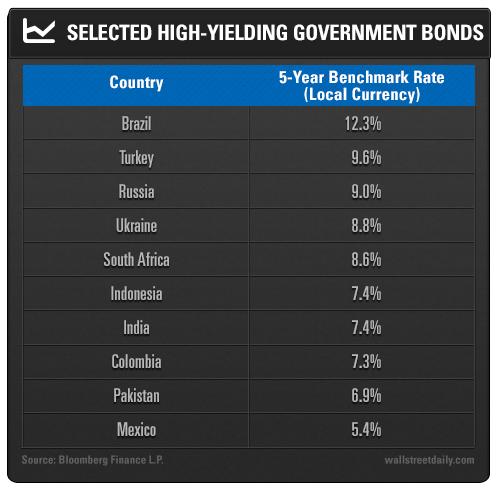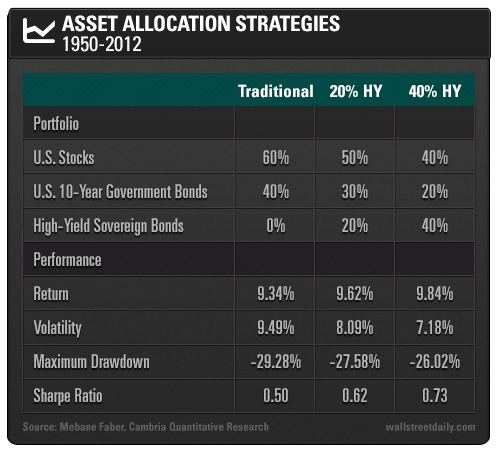In early 1998, Russia was hemorrhaging foreign exchange reserves.
A number of factors were feeding into worries about Russia’s debt sustainability – including the Asian financial crisis in 1997, a decline in the price of crude oil, political instability, and widening fiscal deficits.
Emergency loans from the International Monetary Fund and World Bank did little to stem the tide. On August 17, 1998, Russia devalued its currency (the ruble) and chose to default on its debt.
The Russian crisis serves as a warning: Even government bonds can be very risky.
Is the Risk Worth the Reward?
Today, Russia’s 5-Year government bonds yield around 9%.
In fact, Russia’s sovereign bonds are among the highest yielding of any country, as you can see in the following table:

In a world seemingly starved for yield, these rates are all rather high.
Indeed, very few investors like the sovereign debt in the table above because the perceived risks are significant.
Several countries’ economies on this list have suffered damage from the plunge in commodity prices, and many are in the throes of political turmoil or nasty recessions.
There’s a lot to be worried about. Hence, these bonds are unpopular.
But if popular investments should usually be avoided, then could these unloved bonds actually be attractive investments?
High-Yield Sovereigns
Typically, “high-yield” refers to sub-investment grade corporate bonds, or junk bonds.
In “Finding Yield in a 2% World,” Mebane Faber, Chief Investment Officer at Cambria Investment Management, back-tested a high-yield government bond strategy.
The universe comprised 30 countries from the Global Financial Data database and is sorted based on nominal yield. The top one-third of the bonds are bought, with periodic reconstitution.
The results were fairly surprising.
From 1950 to 2012, the high-yield strategy actually outperformed an equal weighting of all countries in the universe by around 2% per annum.
The outperformance was also consistent across decades, including both rising and falling interest rate environments.
The returns were U.S. dollar-based, but over the very long term, local real returns should be similar.
The high-yield bond portfolio also seems to have outstanding diversification benefits.
The table below compares the performance metrics for a traditional 60/40 portfolio, with those of portfolios having 20% and 40% allocations to sovereign high-yield bonds.

As the allocation to high-yield government bonds increases, returns rise, volatility decreases, and maximum drawdowns (peak-to-trough declines) are reduced.
The more favorable risk/reward relationship is also shown by the rising Sharpe Ratio.
Miraculously, adding unpopular, high-yielding sovereign bonds to a traditional portfolio can actually reduce risk, while increasing returns.
Now, for most retail investors, buying sovereign bonds issued by Indonesia would prove challenging, to say the least.
But there’s now a viable option…
ETF to the Rescue
Luckily, Faber’s firm launched the Cambria Sovereign High-Yield Bond ETF (SOVB) earlier this year.
SOVB is one of the many new exchange-traded funds (ETFs) that gives investors convenient and cheap access to promising strategies.
The ETF systematically buys the highest-yielding sovereign and quasi-sovereign bonds with sufficient liquidity.
SOVB’s annual expenses are 0.59%, which is reasonable for an ETF that has exposure to smaller bond markets. For example, the WisdomTree Emerging Markets Local Debt (NYSE:ELD) has an expense ratio of 0.55%.
Clearly, the data show that high-yielding government bonds are attractive long-term investments.
Far more often than not, the worst-case scenario – such as a default or currency crisis – doesn’t materialize. Thus, investors wind up more than fairly compensated for risk exposures via the higher yields.
And now that there’s a high-yield government bond ETF, I don’t want to hear any more complaints about the dearth of yield in this environment.
